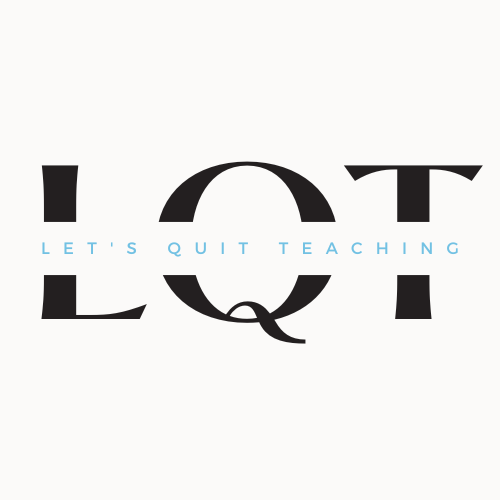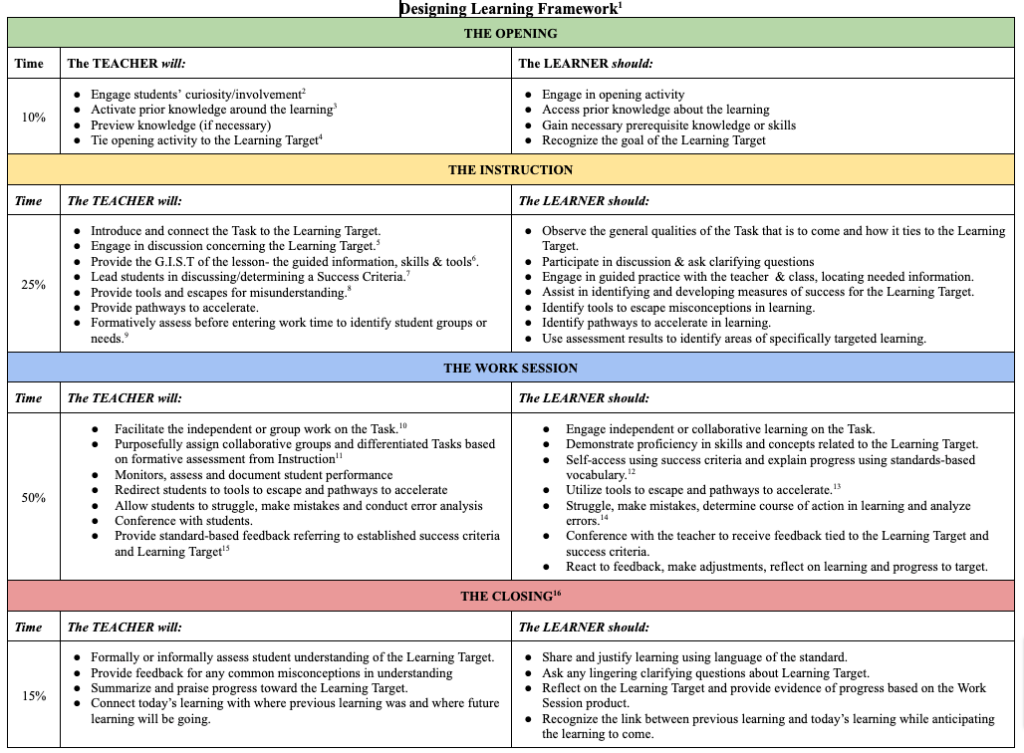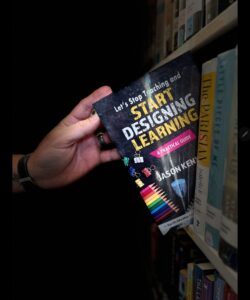If you are reading this, chances are you already know one thing about my work. If I had to sum up everything I believe about education and our jobs in the profession, it would be just one word: Intentional. My fervent belief is this: If we as educators are intentional in two things, we will have success in the classroom: Relationships and Learning. Being intentional requires us to do things on purpose. We interact with kids in a purposeful way, react to them, intentionally choose to form relationships with them. We choose these things, and these matter to learning. The relationship piece is one part, but the intentional design of learning is another. That is where a framework for Tier 1 instruction comes in handy.
The framework image at the beginning of this post can be accessed HERE. Again, if you are familiar with me, my recent book walks you through this framework with practical guidance for any grade level or content teacher.
What a Framework Does
Gives Boundaries
Using a framework provides teachers with a valuable boundary within which they can operate effectively. Designing a learning experience with a functional framework ensures that learning is at the core of everything that happens. It emphasizes that teaching alone, no matter how passionate or well-intentioned, cannot replace well-designed learning experiences. The framework offers a structured approach that both teachers and learners can become familiar with. This common format eases the cognitive load on students, enabling them to focus on the content and learning process rather than constantly adapting to new classroom structures.
Delivers Impact
John Hattie’s mantra is “Know Thy Impact.” Using a framework that utilizes identified high-impact elements that evidence says works ensures that we are designing learning at a high level for every learner in the room. A framework underscores the importance of designing education experiences with a clear and deliberate intent to maximize learning outcomes. This impact-centric approach is essential, especially for students who may require accelerated, which is what we all seem to be chasing post-pandemic. If we are not designing and delivering with impact in the classroom and then going back to inspect our impact after the learning has occurred, we are not doing our jobs as educators. Bottom line.
Focuses Intention
A framework serves as a tool for honing and directing intention in learning. By outlining key components, it offers educators a structured approach to crafting intentional learning experiences. It emphasizes that the process of teaching should be purposeful, with each component designed to have a specific impact on learning. This encourages teachers to make deliberate choices that align with their educational objectives, ensuring that every aspect of the learning process serves a clear and targeted purpose. Again, everything we do for learning should be intentional. Frameworks help us do this!
What a Framework Does Not
Stifle Creativity
A framework is not a teacher creativity killer. I tend to think of it like an artist working within the constraints of a canvas size. The framework is not prescriptive but rather provides a structured canvas within which teachers can exercise their creativity to design engaging and effective learning experiences. Teachers are encouraged to use their creativity to fine-tune their instructional choices, aligning them with the framework’s components. In fact, the framework enhances creativity by providing a clear purpose and direction for educators. It ensures that creative choices are aligned with the goal of facilitating impactful learning, ultimately enabling teachers to become designers of learning experiences that are both engaging and effective.
Limit Autonomy
If there was one thing I detested as a teacher in the classroom, it was having to follow a scripted, prescribed curriculum just like everyone else in the department. A framework doesn’t limit the autonomy of a teacher, despite the common concern about it being overly prescriptive. Like the artist reference above, I can give five painters the same canvas, but all five will produce different works of art. A framework doesn’t dictate every aspect of teaching but instead serves as a guideline for structuring the learning experience. Teachers are still free to make decisions and adapt the framework to best suit their teaching style, learners’ needs, and educational goals. Autonomy remains intact, as the framework is a supportive structure rather than a restrictive set of rules, allowing teachers to design learning experiences that are both effective and personally tailored for the learners in the room.
Ignore Supports
A framework for Tier 1 does not ignore the needs of learners who require additional support and assistance. It acknowledges that some learners may be behind in their learning while also placing a strong emphasis on intentionally designing learning experiences with a clear understanding of the diverse needs of students. It promotes the consistent application of high-impact, universal practices, which are essential for ensuring that all learners, especially those who need extra support, can make substantial progress. By integrating these practices into the daily delivered framework, teachers can provide the necessary assistance for learners who may be facing challenges in their learning journey, without compromising the quality and effectiveness of the educational experience for the entire class. Thus, the framework does not ignore the fact that some may need more support; it actually facilitates and accommodates this support while maintaining a focus on optimizing learning outcomes for all.
Framework is not the F word in education. It can do a great deal for us as designers of learning. It doesn’t confine our creativity; it empowers us to craft unique masterpieces in the realm of teaching. It respects our autonomy, ensuring that each classroom remains a stage for individual expression. And most importantly, it never forgets the diverse needs of our learners, underscoring that inclusivity and support are at its very core. In a world where education is constantly evolving, a framework is our compass, helping us navigate the journey of teaching with intention, impact, and unwavering dedication to the limitless potential of every student. So, let us embrace the framework, not as a restriction, but as an ally in our mission to design the best learning possible for our learners.
I currently work with other schools and districts on how to design high effective learning intentionally for learning. If you would like to learn more, please check out Let’s Stop Teaching and Start Designing Learning: A Practical Guide or reach out at letsquitteaching@gmail.com for collaboration, workshop or presentation opportunities.


